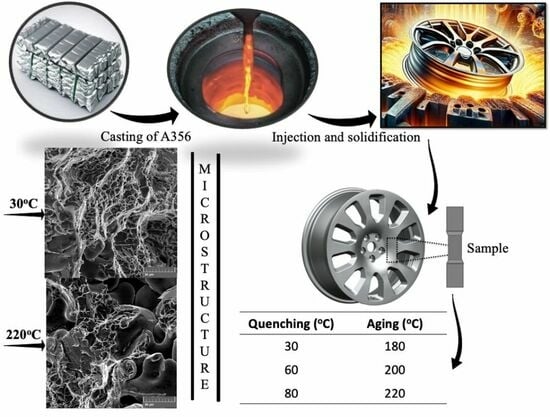Planning Mechanical Behavior of A356 Alloy Wheels by Using Distinct Heat Treatments
Abstract
:1. Introduction
2. Experimental Procedure
2.1. Die Casting Sample Preparation
2.2. Heat Treatments
2.3. The Sample Characterization
3. Results and Discussion
3.1. Quenching and Aging Effects on Mechanical Behavior
3.2. XRD and DSC Characterizations
3.3. Microstructural Array and Fractograph Characterizations
4. Conclusions
- When the A356 alloy samples are quenched at 30, 60, and 80 °C, decreasing trends in both UTS and YS results are observed. Analog tendencies are also obtained when aging treatments at 180, 200, and 220 °C are applied. It was found that the UTS results corresponding with the aging at 180 °C and quenching at 30 °C are similar (i.e., ~240 MPa). Analog YS results are also similar in these same treatment temperature ranges, i.e., ~190 MPa.
- When comparing the experimental correlations between UTS and YS with microhardness with those previously reported (e.g., Krishna et al. [43] and Cerri and Ghio [42]), a good exponential adjustment prescribes the experimental data. On the other hand, when linear equations proposed by Abdulwahab et al. [40] and Rometsch and Schaffer [39] are utilized, no good adjustments are obtained.
- It was found that the calculated microstrains, crystallite sizes, and dislocation densities from the Rietveld treatments corroborate our understanding of the distinctive mechanical behavior of the A356 alloy samples subjected to different aging and quenching treatments. We found that the dislocations are responsible for similar UTS and YS values when compared with those samples quenched at 30 °C and aged at 180 °C. It was also found that by using the Rietveld treatment, the dislocation densities are calculated and correlation with mechanical responses can be constituted.
- It is important to remember that industrial practices commonly use artificial aging after a quenching procedure. However, for automotive wheels, it is noted that a complementary powder coating wheel treatment is often applied. This can promote a certain curing of coating, which prevents corrosion damage and provides a shiny aesthetic aspect. Although certain industrial secrets are required, this abovementioned curing coating treatment takes up to 2 h at 160 and 180 °C to complete. In this particular context, it seems that it is thermodynamically sufficient for a “preaging” or “overaging” to be conducted. We found that a “quasi-overaging” of the wheels results in a deleterious effect on mechanical behavior. This is attributed to “overaging” when associated with T6. With this, operational practices can be planned in order to obtain the required mechanical properties, which is particularly useful for manufacturers of A356 alloy wheels.
Author Contributions
Funding
Data Availability Statement
Acknowledgments
Conflicts of Interest
References
- Abdelaziz, M.H.; Samuel, A.M.; Doty, H.W.; Samuel, F.H. Effect of morphological changes of eutectic Si particles on the ambient and high temperature tensile properties of Zr containing Al–Si alloys. J. Mater. Res. Tecnol. 2020, 9, 5962–5981. [Google Scholar] [CrossRef]
- Zhang, H.; Yu, S.; Yang, Z.; Zhang, C. The influence of porosity and precipitates on the corrosion behavior of A356 aluminum alloy. J. Electroanal. Chem. 2023, 948, 117796. [Google Scholar] [CrossRef]
- Ortiz, E.L.; Osório, W.R.; Bortolozo, A.D.; Padilha, G.S. Alternative liquid-assisted sintering of Al/Cu composites using selected powders of As-Cast Al-Zn alloy. Metals 2022, 12, 962. [Google Scholar] [CrossRef]
- Gu, G.; Li, R.; Xiang, L.; Zheng, H.; Lv, Y. Semi-solid Die Casting of Some Aluminum Alloys for Lightweight Automotive Components. In Proceedings of the International Conference on the Technology of Plasticity, Mandelieu-La Napoule, France, 24–29 September 2023; pp. 249–257. [Google Scholar]
- Berlanga-Labari, C.; Biezma-Moraleda, M.V.; Rivero, P.J. Corrosion of cast aluminum alloys: A review. Metals 2020, 10, 1384. [Google Scholar] [CrossRef]
- Samuel, E.; Samuel, A.M.; Songmene, V.; Samuel, F.H. A review on the analysis of thermal and thermodynamic aspects of grain refinement of aluminum-silicon-based alloys. Materials 2023, 16, 5639. [Google Scholar] [CrossRef] [PubMed]
- Caceres, C.H.; Griffiths, J.R. Damage by the cracking of silicon particles in an Al-7Si-0.4Mg casting alloy. Acta Mater. 1996, 44, 25–33. [Google Scholar] [CrossRef]
- Samuel, E.; Tahiri, H.; Samuel, A.M.; Songmene, V.; Samuel, F.H. A review on fundamentals of grain refining of Al-Si cast alloys. Recent Adv. Alum. Alloys 2024. [Google Scholar] [CrossRef]
- Chen, Z.; Wang, T.; Gao, L.; Fu, H.; Li, T. Grain refinement and tensile properties improvement of aluminum foundry alloys by inoculation with Al–B master alloy. Mater. Sci. Eng. A 2012, 553, 32–36. [Google Scholar] [CrossRef]
- Dang, B.; Liu, C.-C.; Liu, F.; Liu, Y.-Z.; Li, Y.-B. Effect of as-solidified microstructure on subsequent solution-treatment process for A356 Al alloy. Trans. Nonferrous Met. Soc. China 2016, 26, 634–642. [Google Scholar] [CrossRef]
- Samuel, A.M.; Samuel, E.; Songmene, V.; Samuel, F.H. A comparative study of grain refining of Al-(7–17%) Si cast alloys using Al-10% Ti and Al-4% B master alloys. Materials 2023, 16, 2867. [Google Scholar] [CrossRef]
- Easton, M.A.; Prasad, A.; St John, D.H. The grain refinement of Al-Si alloys and the cause of Si poisoning: Insights revealed by the interdependence model. Mater. Sci. Forum 2014, 6, 161–166. [Google Scholar] [CrossRef]
- Elias, A.L.P.; Koizumi, M.S.; Ortiz, E.L.; Rodrigues, J.F.Q.; Bortolozo, A.D.; Osório, W.R.; Padilha, G.S. Corrosion behavior of an Al-Si casting and a sintered Al/Si composite immersed into biodiesel and blends. Fuel Process. Technol. 2020, 202, 106360. [Google Scholar] [CrossRef]
- El Haj, B.A.; Hamadellah, A.; Bouayad, A.; El Akili, C. Review of grain refinement performance of aluminium cast alloys. Metall. Mater. Eng. 2023, 29, 1–15. [Google Scholar] [CrossRef]
- Jiang, D.; Yu, J. Simultaneous refinement and modification of the eutectic Si in hypoeutectic Al–Si alloys achieved via the addition of SiC nanoparticles. J. Mater. Res. Technol. 2019, 8, 2930–2943. [Google Scholar] [CrossRef]
- Jin, B.-R.; Ha, D.-W.; Jeong, C.-Y. Effect of solution treatment on the hardness and tensile properties of Al–Mg–Si alloys for automotive chassis. Mater. Trans. 2019, 60, 815–823. [Google Scholar] [CrossRef]
- Liu, G.; Gao, J.; Che, C.; Lu, Z.; Yi, W.; Zhang, L. Optimization of casting means and heat treatment routines for improving mechanical and corrosion resistance properties of A356-0.54Sc casting alloy. Mater. Today Commun. 2020, 24, 101227. [Google Scholar] [CrossRef]
- Wei, B.; Li, S.; Jiang, T.; Zhang, Y.; Xu, G.; Li, Y.; Wang, Z. Optimization of Si content to inhibit inhomogeneous deformation in Al-Mg-Si alloy fabricated via twin-roll casting. Metals 2022, 12, 941. [Google Scholar] [CrossRef]
- Xia, G.; Zhao, Q.; Ping, X.; Zhang, Y.; Yu, Q.; Li, Z.; Cai, Q. Effect of Al–5Ti–1B–La intermediate alloy on microstructure and mechanical properties of A356 aluminum alloy. J. Mater. Res. Technol. 2024, 7, 036535. [Google Scholar]
- De Oliveira Santos, P.G.B.; Gomes, L.F.; Spinelli, J.E. Solidification and strength behavior of A356 Al alloy wheels. Int. J. Met. 2024, 1–19. [Google Scholar] [CrossRef]
- Miller, A.E.; Maijer, D.M. Investigation of erosive-corrosive wear in the low pressure die casting of aluminum A356. Mater. Sci. Eng. A 2006, 435–436, 100–111. [Google Scholar] [CrossRef]
- Ozturk, F.; Sisman, A.; Toros, S.; Kilic, S.; Picu, R.C. Influence of aging treatment on mechanical properties of 6061 aluminum alloy. Mater. Des. 2010, 31, 972–975. [Google Scholar] [CrossRef]
- Yang, C.-L.; Li, Y.-B.; Dang, B.; Lu, H.-B.; Liu, F. Effects of cooling rate on solution heat treatment of as-cast A356 alloy. Trans. Nonferrous Met. Soc. China 2015, 25, 3189–3196. [Google Scholar] [CrossRef]
- Zhang, X.L.; Liu, J.H.; Li, W.S.; Zhou, H.T.; Wang, S.C. Effect of Sr–Ce modification on the microstructure and mechanical properties of A356 alloy. Int. J. Met. 2023, 17, 1008–1020. [Google Scholar] [CrossRef]
- Roy, M.J.; Maijer, D.M. Response of A356 to warm rotary forming and subsequent T6 heat treatment. Mater. Sci. Eng. A 2014, 611, 223–233. [Google Scholar] [CrossRef]
- Shabestari, S.G.; Shahri, F. Influence of modification, solidification conditions and heat treatment on the microstructure and mechanical properties of A356 aluminum alloy. J. Mater. Sci. 2004, 39, 2023–2032. [Google Scholar] [CrossRef]
- Sjölander, E.; Seifeddine, S. The heat treatment of Al-Si-CuMg casting alloys. J. Mater. Process. Technol. 2010, 210, 1249–1259. [Google Scholar] [CrossRef]
- Xu, C.L.; Wang, H.Y.; Qiu, F.; Yang, Y.F.; Jiang, Q.C. Cooling rate and microstructure of rapidly solidified Al-20 wt. % Si alloy. Mater. Sci. Eng. A 2006, 417, 275–280. [Google Scholar] [CrossRef]
- Chen, R.; Shi, Y.-F.; Xu, Q.-Y.; Liu, B.-C. Effect of cooling rate and microstructure of Al-7Si-0.3Mg-0.15Fe alloys. Trans. Nonferrous Met. Soc. China 2014, 24, 1645–1652. [Google Scholar] [CrossRef]
- Osório, W.R.; Cheung, N.; Spinelli, J.E.; Goulart, P.R.; Garcia, A. The effects of a eutectic modifier on microstructure and surface corrosion behavior of Al-Si hypoeutectic alloys. J. Solid State Electrochem. 2007, 11, 1421–1427. [Google Scholar] [CrossRef]
- Osório, W.R.; Cheung, N.; Spinelli, J.E.; Cruz, K.S.; Garcia, A. Microstructural modification by laser surface remelting and its effect on the corrosion resistance of an Al–9 wt% Si casting alloy. Appl. Surf. Sci. 2008, 254, 2763–2770. [Google Scholar] [CrossRef]
- Apelian, D.; Shivkumar, S.; Sigworth, G. Fundamental aspects of heat treatment of cast Al-Si-Mg alloys. AFS Trans. 1989, 97, 727–742. [Google Scholar]
- Mahan, H.M.; Konovalov, S.V.; Panchenko, I. Effect of heat treatment on the mechanical properties of the aluminium alloys AA2024 with nanoparticles. Int. J. Appl. Sci. Eng. 2023, 20, 2022324. [Google Scholar] [CrossRef]
- Wang, Q.G.; Cáceres, C.H. On the strain hardening behaviour of Al-Si-Mg casting alloys. Mater. Sci. Eng. A 1997, 234–236, 106–109. [Google Scholar] [CrossRef]
- Tiryakioglu, M. The effect of solution treatment and artificial aging on the work hardening characteristics of a cast Al–7%Si– 0.6%Mg alloy. Mater. Sci. Eng. A 2006, 427, 154–159. [Google Scholar] [CrossRef]
- Campbell, J.; Tiryakioglu, M. Review of effect of P and Sr on modification and porosity development in Al–Si alloys. Mater. Sci. Technol. 2010, 26, 262–268. [Google Scholar] [CrossRef]
- Dash, S.S.; Chen, D. A review on processing–microstructure–property relationships of Al-Si alloys: Recent advances in deformation behavior. Metals 2023, 13, 609. [Google Scholar] [CrossRef]
- Chen, L.; Zhao, Y.; Wen, Z.; Tian, J.; Hou, H. Modelling and optimization for heat treatment of Al-Si-Mg alloy prepared by indirect squeeze casting based on response surface methodology. Mater. Res. 2017, 20, 1274–1281. [Google Scholar] [CrossRef]
- Rometsch, P.A.; Schaffer, G.B. An age hardening model for Al–7Si–Mg casting alloys. Mater. Sci. Eng. A 2002, 325, 424–434. [Google Scholar] [CrossRef]
- Abdulwahab, M.; Madugu, I.A.; Yaro, S.A.; Hassan, S.B.; Popoola, A.P.I. Effects of multiple-step thermal ageing treatment on the hardness characteristics of A356.0-type Al-Si-Mg alloy. Mater. Des. 2011, 32, 1159–1166. [Google Scholar] [CrossRef]
- Sekhar, A.P.; Nandy, S.; Ray, K.K.; Das, D. Hardness- yield strength realtion of Al-Mg-Si alloys. IOP Conf. Ser. Mater. Sci. Eng. 2018, 338, 012011. [Google Scholar] [CrossRef]
- Cerri, E.; Ghio, E. AlSi10Mg alloy produced by selective laser melting: Relationships between Vickers microhardness, Rockwell hardness and mechanical properties. Metall. Ital. 2020, 7–8, 5–17. [Google Scholar]
- Krishna, S.C.; Gangwar, N.K.; Jha, A.K.; Pant, B. On the prediction of strength from hardness for copper alloys. J. Mater. 2013, 9–10, 1–6. [Google Scholar] [CrossRef]
- Ungár, T. Dislocation densities, arrangements and character from X-ray diffraction experiments. Mater. Sci. Eng. A 2001, 309–310, 14–22. [Google Scholar] [CrossRef]
- Ungár, T.; Ott, S.; Sanders, P.G.; Borbély, A.; Weertman, J.R. Dislocations, grain size and planar faults in nanostructured copper determined by high resolution X-ray diffraction and a new procedure of peak profile analysis. Acta Mater. 1998, 46, 3693–3699. [Google Scholar] [CrossRef]
- Sutapa, I.W.; Wahab, A.W.; Taba, P.; Nafie, N.L. Dislocation, crystallite size distribution and lattice strain og magnesium oxide nanoparticles. J. Phys. Conf. Ser. 2018, 979, 01221. [Google Scholar] [CrossRef]
- Wang, C.; Wang, Z.; Xu, H.; Zhang, G. Decreased dislocation density as an origin for the quench sensitivity of the Al-Si-Mg alloys with high Si content. J. Alloys Compd. 2022, 910, 165011. [Google Scholar] [CrossRef]
- Muiruri, A.; Maring, M.; Preez, W. Evaluation of dislocation densities in various microstructures of additively manufactured Ti6Al4V (eli) by method of X-ray diffraction. Materials 2022, 13, 5355. [Google Scholar] [CrossRef]
- Kavosi, J.; Saei, M.; Kazeminezhad, M.; Dodangeh, A. Modeling of dislocation density and strength on rheoforged A356 alloy during multi-directional forging. Comput. Mater. Sci. 2014, 81, 284–289. [Google Scholar] [CrossRef]
- Teng, D.; Zhang, G.; Zhang, S.; Li, J.; Guan, R. Mechanical properties of refined A356 alloy in response to continuous rheological extruded Al-5Ti-0.6C-1.0Ce alloy prepared at different temperatures. Metals 2023, 13, 1344. [Google Scholar] [CrossRef]
- Dewangan, S.; Selvaraj, S.K.; Karthikeyan, B.; Chadha, U.; Singhal, P.; Sarma, P.P.; Raju, P.V.; Kumar, U.; Kumar, M.P. Fractography analysis into low-C steel undergone through various destructive mechanical tests. Mater. Res. Express 2022, 9, 126502. [Google Scholar] [CrossRef]
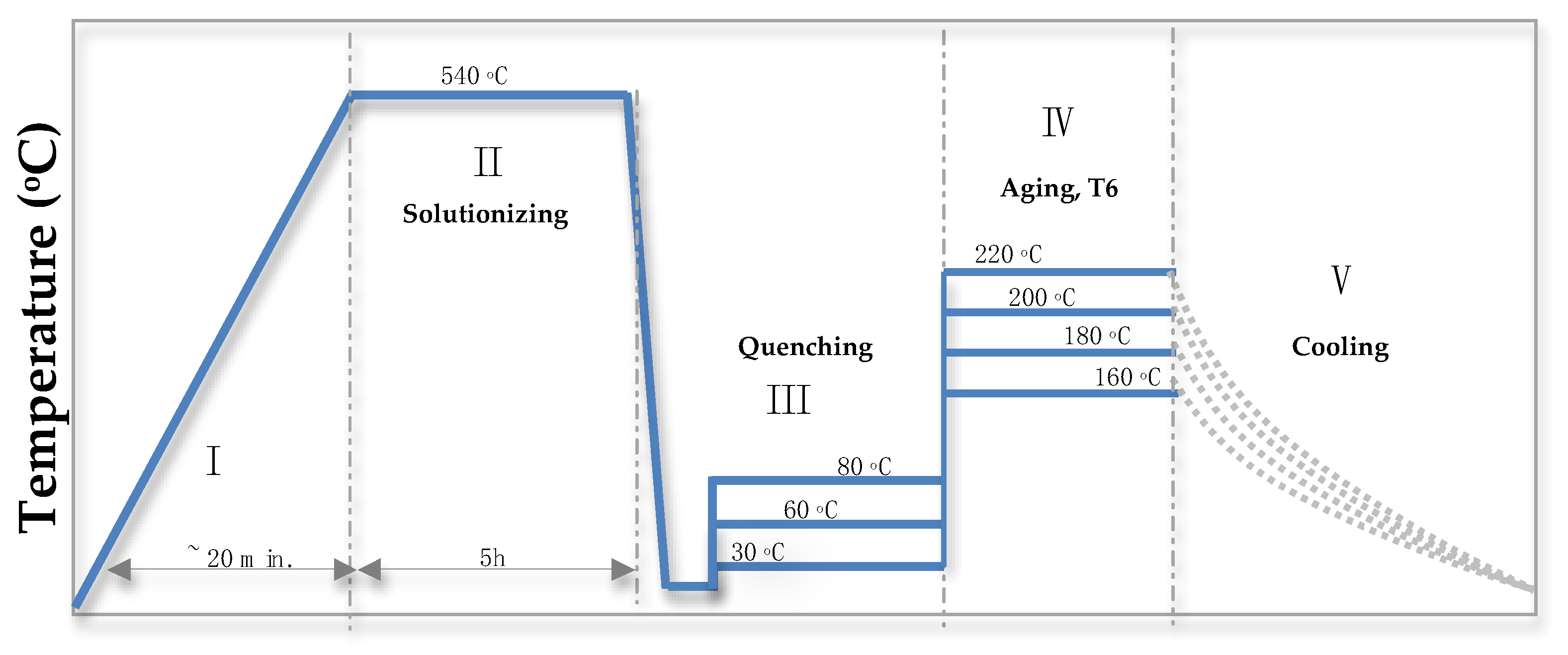
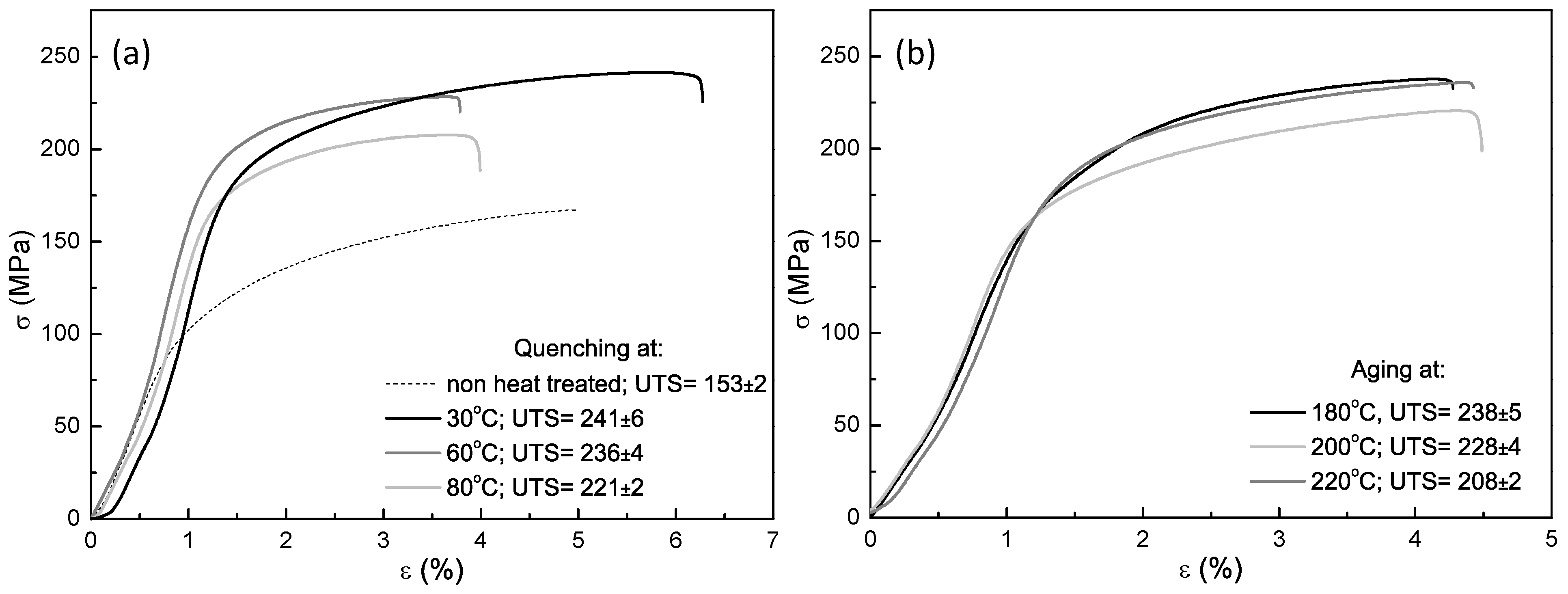
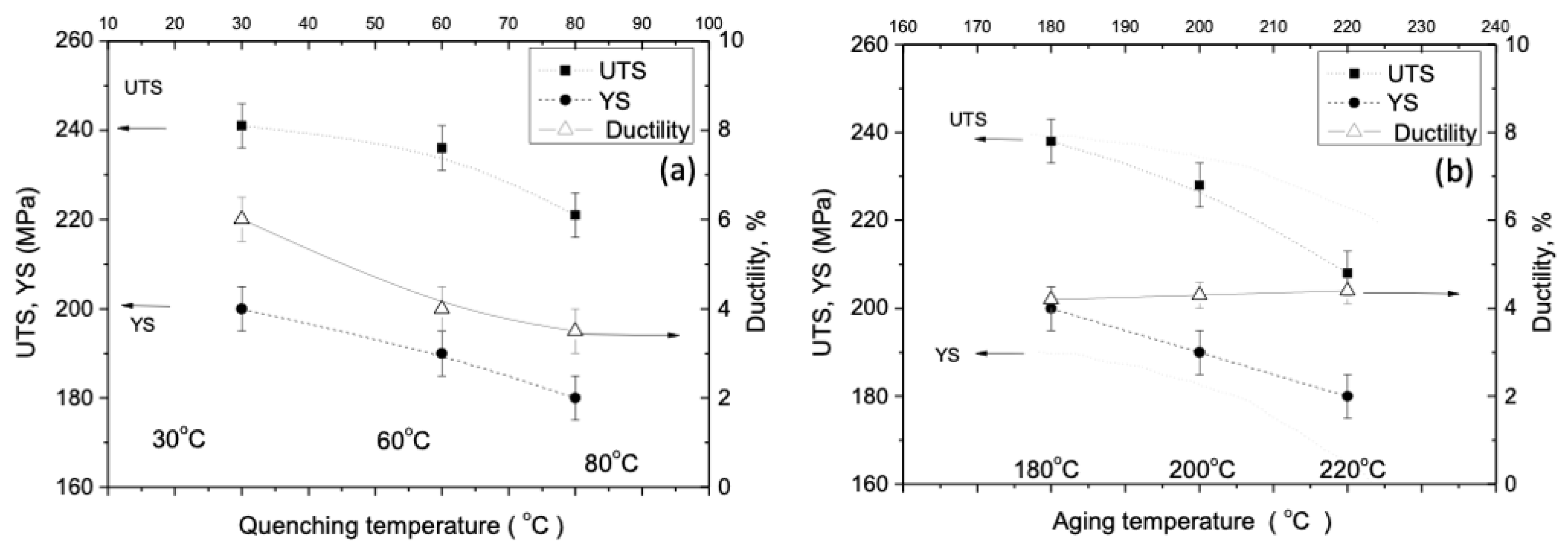
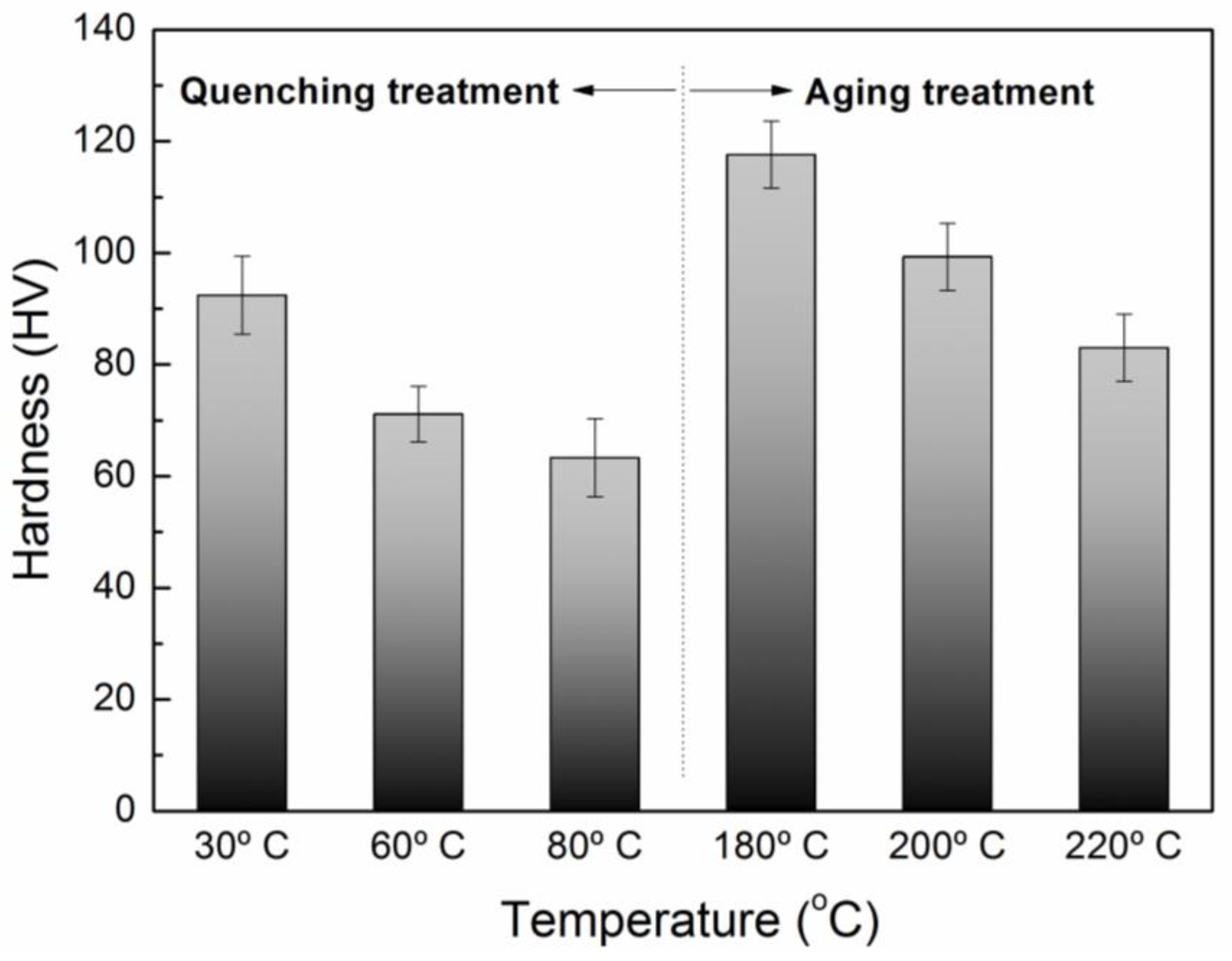
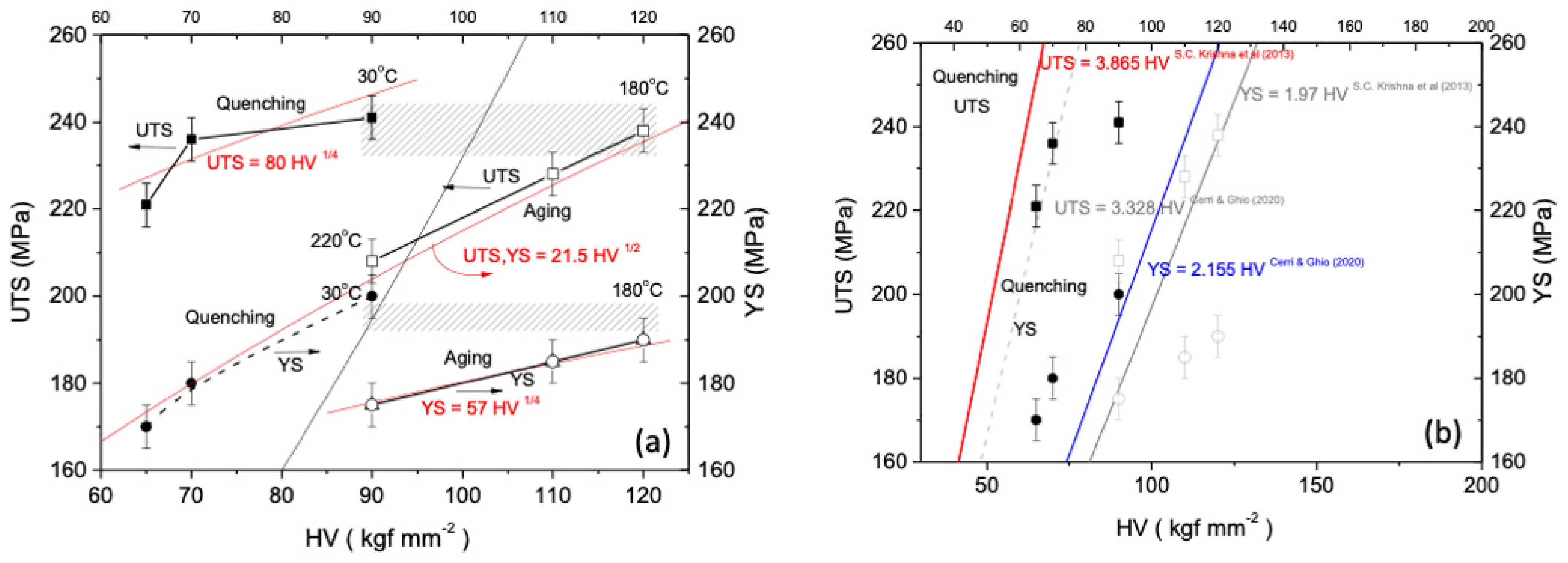
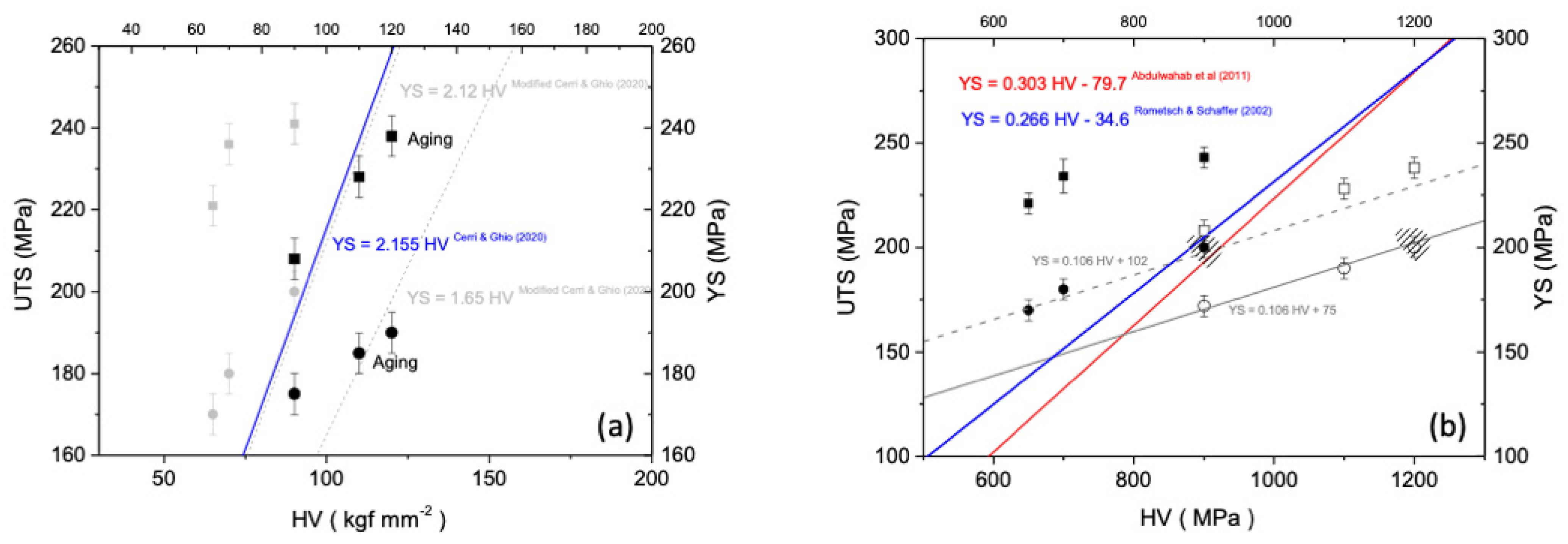
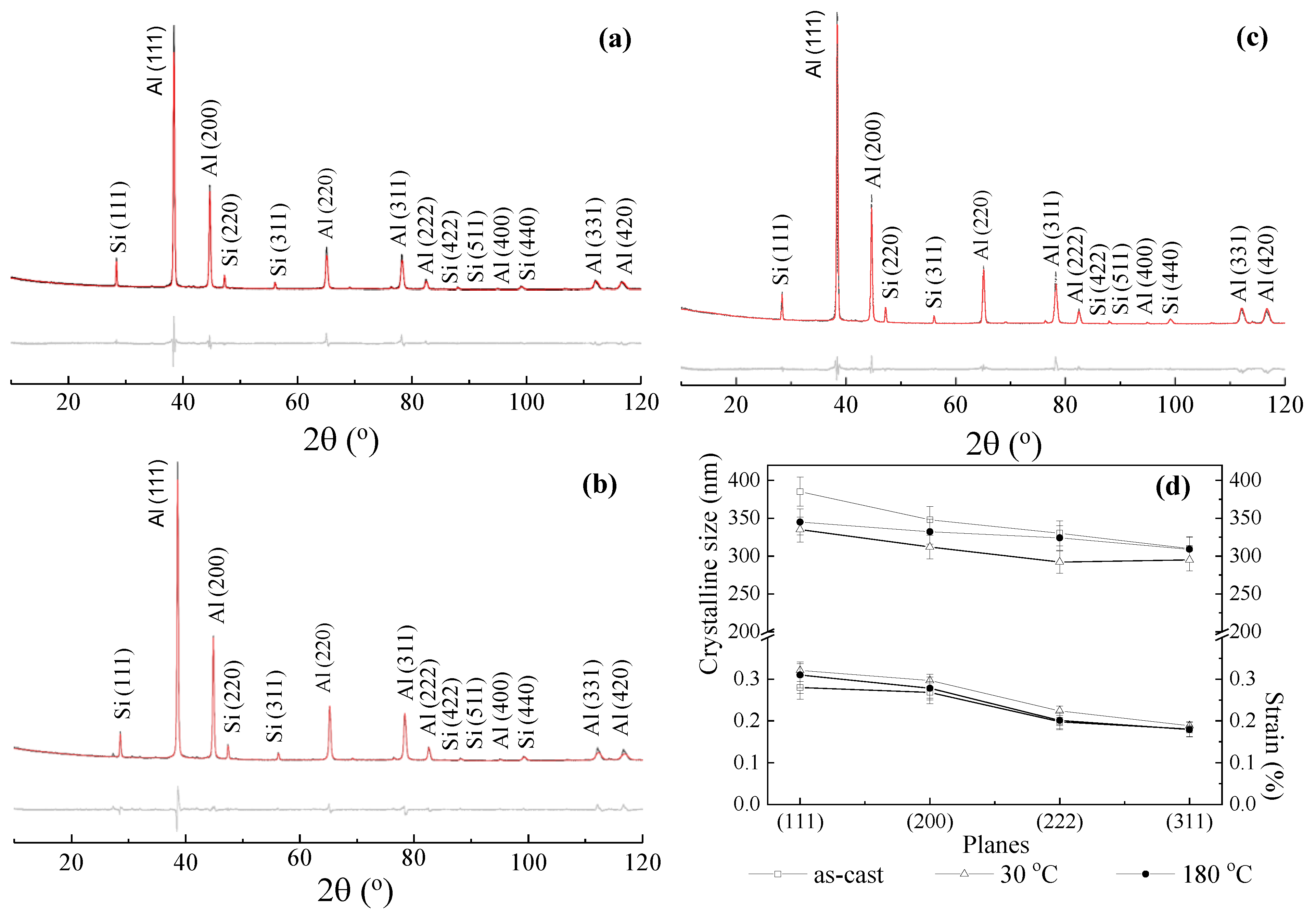
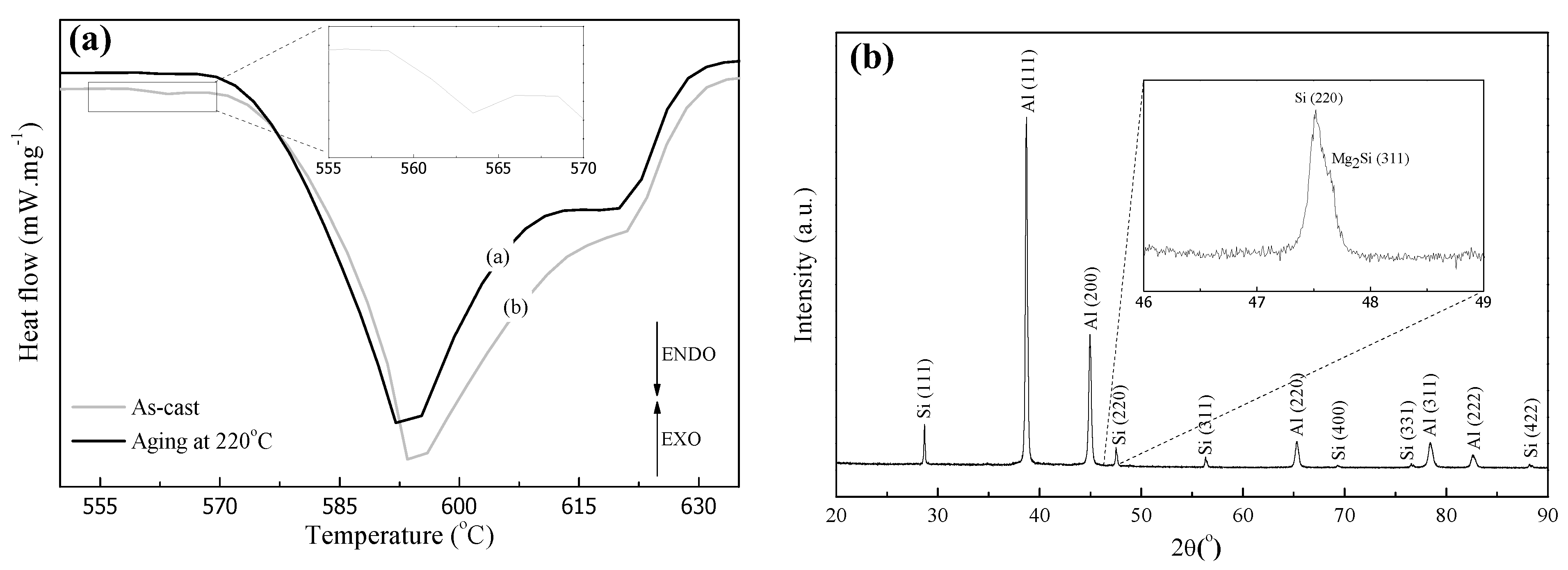
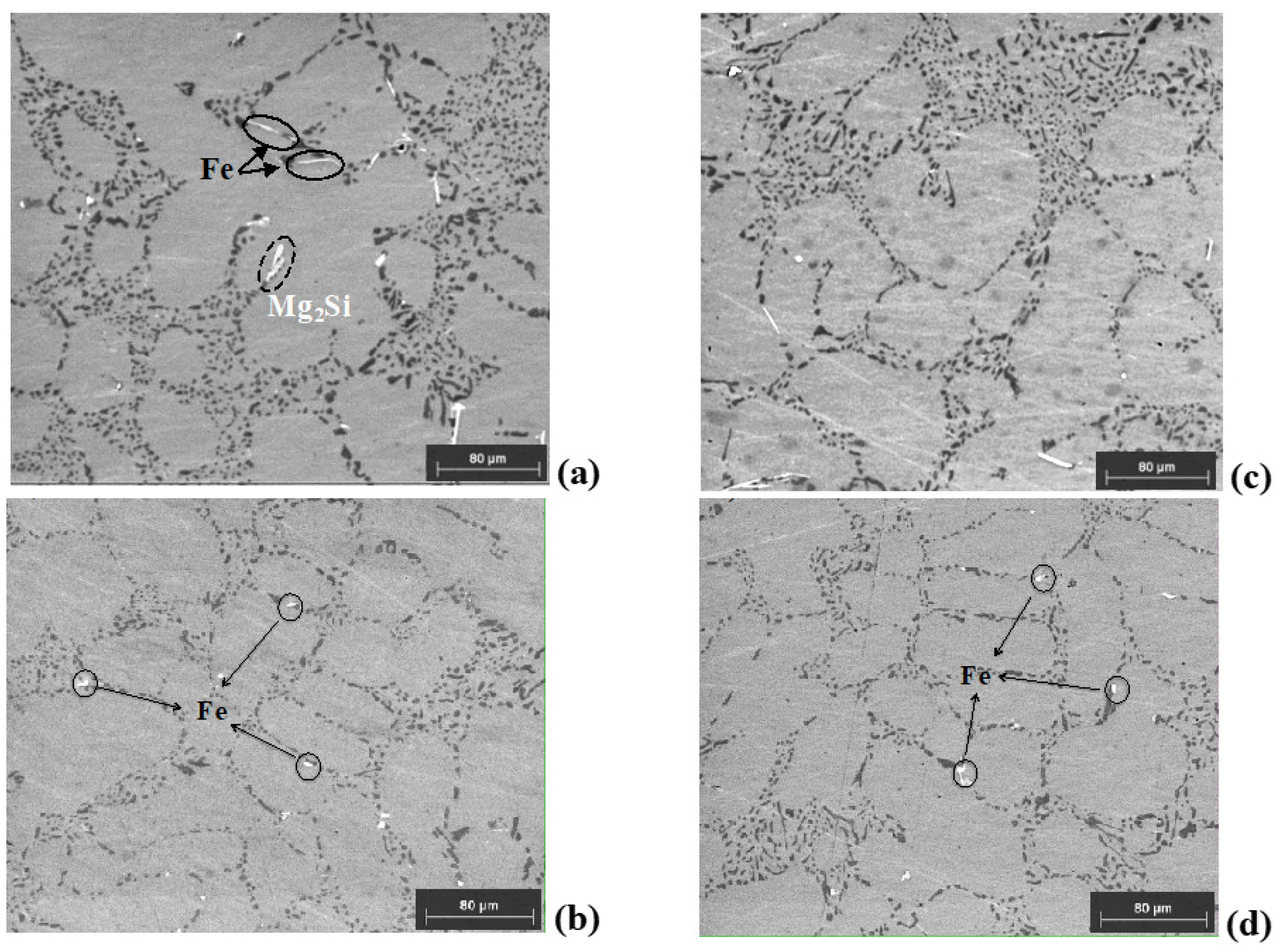

| Alloying Elements | Si | Mg | Cu | Fe | Ti | Sr | Al |
|---|---|---|---|---|---|---|---|
| Min. content (%wt.) | 6.5 | 0.2 | ---- | --- | 0.1 | 0.01 | Balance |
| Max. content (%wt.) | 7.5 | 0.45 | 0.2 | 0.3 | 0.2 | 0.02 | Balance |
| As-Cast | Quenched at 30 °C | Aging at 180 °C | |
|---|---|---|---|
| ρ (m−2 × 1015) | |||
| (200) | 6.2 (±0.2) | 7.2 (±0.2) | 7.9 (±0.2) |
| (111) | 7.9 (±0.2) | 8.9 (±0.2) | 9.4 (±0.2) |
Disclaimer/Publisher’s Note: The statements, opinions and data contained in all publications are solely those of the individual author(s) and contributor(s) and not of MDPI and/or the editor(s). MDPI and/or the editor(s) disclaim responsibility for any injury to people or property resulting from any ideas, methods, instructions or products referred to in the content. |
© 2024 by the authors. Licensee MDPI, Basel, Switzerland. This article is an open access article distributed under the terms and conditions of the Creative Commons Attribution (CC BY) license (https://creativecommons.org/licenses/by/4.0/).
Share and Cite
Tonetti, A.L.; Osório, W.R.; Bortolozo, A.D.; Padilha, G.S. Planning Mechanical Behavior of A356 Alloy Wheels by Using Distinct Heat Treatments. Metals 2024, 14, 461. https://doi.org/10.3390/met14040461
Tonetti AL, Osório WR, Bortolozo AD, Padilha GS. Planning Mechanical Behavior of A356 Alloy Wheels by Using Distinct Heat Treatments. Metals. 2024; 14(4):461. https://doi.org/10.3390/met14040461
Chicago/Turabian StyleTonetti, Adriano L., Wislei R. Osório, Ausdinir D. Bortolozo, and Giovana S. Padilha. 2024. "Planning Mechanical Behavior of A356 Alloy Wheels by Using Distinct Heat Treatments" Metals 14, no. 4: 461. https://doi.org/10.3390/met14040461





